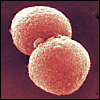 Inexplicably absent from the current fad for Scandi-dramas is a mystery thriller set among the geysers, glaciers and Guðmundsdóttirs of Iceland.
Inexplicably absent from the current fad for Scandi-dramas is a mystery thriller set among the geysers, glaciers and Guðmundsdóttirs of Iceland.
One compelling candidate for filling this void is Prof Karl Gústaf Kristinsson, a medical microbiologist at Reykjavík's Landspitali University Hospital, and his quest to tell the story of the superbug PMEN2.
The pneumococcal detective

Prof Kristinsson has been on the case of Icelandic varieties of the multidrug resistant pneumococcus PMEN2 since the early 1990s, just a few years after it first invaded the island.
Rather than a red jumper, his tools of investigation have been a variety of molecular biology techniques, such as Sanger sequencing and restriction enzyme digests, which he has used to characterize the genotypes of Streptococcus pneumonia isolates and so trace the outbreak's evolution.
Whereas Prof Kristinsson's progress on the superbug's epidemiology in the pre-genomic era was dependent on the slow and laborious molecular biology methods of the day, researchers across the sea at the UK's Wellcome Trust Sanger Centre have been pioneers in microbial genomics, a much more powerful tool for deconstructing the genetics of an outbreak.
In recent years, Stephen Bentley, Julian Parkhill and their colleagues at the Sanger have published a number of studies that apply their microbial genomics expertise to whole-genome sequence data for large numbers of isolates, in order to track the emergence and evolution of notable pathogen strains.

In an article published today in BMC Biology, the Sanger team now add Icelandic PMEN2 to this list, through a collaboration with Prof Kristinsson (as well as Nicholas Croucher, Alexander Tomasz and many other leading microbiologists) that brings the study of the outbreak into the genomics era.
A fatal flaw
With the genomes of 189 S. pneumoniae PMEN2 isolates, the BMC Biology paper is able to answer questions such as:
When did the bacterium acquire drug resistance? How did this multidrug-resistant strain arrive in Iceland? What routes of transmission occurred within the island? What was the nature of the changes to the bug's genetic make-up since its arrival?
Such is the power of forensic genomics, the paper is even able to answer perhaps the most interesting question of all: Why did the superbug's prevalence ultimately decline?
It turns out that Icelandic isolates of PMEN2 had one fatal flaw: due to a disruption in a gene necessary for genetic transformation, they were stuck with a static core genome unable to adapt to changing circumstances. And, thanks to an enlightened public health policy seeking to minimize the use of antibiotics, the bug's circumstances changed in a very fundamental way.
When antibiotic use was widespread, PMEN2's antibiotic resistance genes were an advantage that saw populations soar. But these unsheddable genes became a burden when they no longer served a purpose, and so precipitated a population decline.
Double whammy

If having a core genome laden with burdensome resistance genes wasn't enough bad news for PMEN2, the change in antibiotics policy dealt a second blow.
In common with other 'superbugs', PMEN2 arrived in Iceland armed with multiple antibiotic resistance genes. As is often the case for such genes, some of them were located not in PMEN2's core genome but in mobile genetic elements.
And although the loss of genetic transformation competency made PMEN2's core genome static, it did not affect the ability of mobile DNA to excise itself.
Without the selective pressure of antibiotic use, those resistance genes located on mobile DNA were soon lost from PMEN2's genome, whittling down the total number of resistance genes and so making for a more readily treatable pathogen.
A double whammy for the superbug, which had been simultaneously disarmed and weighed down.
Promiscuous pneumococci
The story of the Icelandic pneumococcal outbreak shows how genomics can back up what we know from common sense about why minimizing antibiotics use is a good idea. That said, the bug in question's immutable genome made it particularly susceptible to such a policy.
For this reason, PMEN2 would have done well to take a leaf out of the book of its fellow multidrug-resistant pneumococcus, PMEN1. A 2012 Sanger Centre study described PMEN1 as 'uniquely promiscuous with its DNA', a trait that has led to its global prevalence – a 'paradigm of genetic success'.
The decline of PMEN2, on the other hand, unmasked its genome as a paradigm of genetic stagnation.
Latest posts by Naomi Attar (see all)
- tRFs and the Argonautes: gene silencing from antiquity - 2nd October 2014
- Keeping up with the Jobses: the role of technology in reproducible research - 26th September 2014
- How to disarm a superbug – a story told by forensic genomics - 23rd June 2014
[…] Inexplicably absent from the current fad for Scandi-dramas is a mystery thriller set among the geysers, glaciers and Guðmundsdóttirs of Iceland.One compelling candidate for filling this void is Prof Karl Gústaf Kristinsson, a medical microbiologist at Reykjavík's Landspitali University Hospital, and his quest to tell the story of the superbug PMEN2.The pneumococcal detectiveProf Kristinsson has been on the case of Icelandic varieties of the multidrug resistant pneumococcus PMEN2 since the early 1990s, just a few years after it first invaded the island.Rather than a red jumper, his tools of investigation have been a variety of molecular biology techniques, such as Sanger sequencing and restriction enzyme digests, which he has used to characterize the …Read more […]